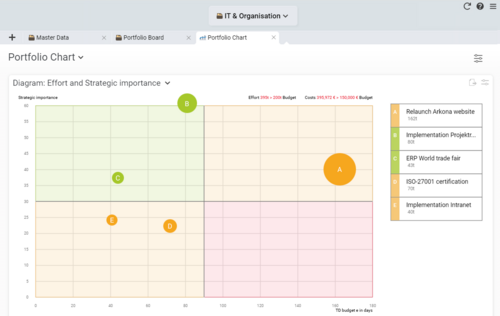08/19/2022 - Articles
What is project portfolio management (PPM)?
What is project portfolio management, in general, what is it used for in companies and what are the tasks of a project portfolio manager? How does it differ from multi-project management and program management? Discover 5 good reasons why you too should get to grips with project portfolio management and use a proven 7-step strategy for your project portfolio management!
What is project portfolio management (PPM)? - A definition
Project portfolio management is the central management of all projects in an organization in order to achieve strategic goals. It therefore encompasses the maintenance and management of the entire project world within an organization, both internal and external projects. In the project management context, it is abbreviated as portfolio management or by the acronym PPM. Usually, project portfolio management is the responsibility of the Project Management Office (PMO), specifically the project portfolio manager.
The portfolio consists of the totality of all programs and projects of an organizational unit. Thus, it contains a collection of projects, but they do not necessarily have to pursue the same or similar goals. Projects within the project portfolio can even compete with each other. A collection of projects that pursue the same substantive goal is called a program.
A portfolio therefore consists of programs and individual projects. Portfolio management comprises the continuous planning, prioritization, overarching control and accompanying controlling of all projects in an organization.

Portfolio management is not about the proper execution of the projects and programs themselves. This is the task of project management and program management. Portfolio management pursues the goal of selecting and executing the right projects.
The term and the concept of project portfolio management have been spreading since 2008 due to the publication of the "Standard for Portfolio Management" by the PMI (Project Management Institute). In the German-speaking world, it has since displaced the term "strategic multi-project management", which had been in use until then. Project portfolio management has been anchored in the German DIN 69909 standard since 2013. The standard is entitled "Multi-project management - Management of project portfolios, programs and projects". Described there are. The DIN standard describes the fundamentals, process models, methods and roles of project portfolio management.
Tasks and goals of the PPM
The core objective of project portfolio management is to maximize the benefits from the projects carried out by the company. To this end, it must ensure that those projects and programs are selected and executed that are most likely to contribute to the company's strategic goals.
Therefore, the most important tasks of project portfolio management and the portfolio manager include:
- Evaluating and prioritizing project proposals (based on opportunities, risks and their strategic importance to the company).
- Approving and rejecting project proposals on the basis of objective data
- Identifying dependencies between (planned and ongoing) projects
- Grouping of projects into portfolios
- Hierarchization of portfolios
- Controlling of ongoing projects
- Coordination of ongoing projects and identification of synergies and conflicts
- Mitigation of risks across projects
- Cross-project resource planning
- Evaluation of completed projects and securing of experience values for follow-up projects
- Definition and initialization of new projects that contribute to the company's objectives
Thus, to achieve the goal of portfolio management, the portfolio manager must identify the projects that will make the greatest contribution to meeting the company's goals. However, since a company has limited resources (budgets and employees), an optimal mix of (external) customer projects and internal projects must be found so that the right projects are carried out at the right time with the available resources. Thus, project portfolio management ensures the profitability and security of an organization's overall project work.
Why Project Portfolio Management? 5 Advantages of PPM
With the help of project portfolio management, you get a real-time, holistic overview of the state and status of:
- Project groups/programs
- Resources
- Dependencies
Effective PPM benefits your project work and your business in five key ways:

1. optimized project selection
Which project should be selected? With PPM, you get clarity about which projects are best suited to achieve the strategic business goals based on the analysis of goals, risks and resources. You thus minimize the danger of focusing on pet projects or prioritizing supposedly simpler projects.
Your project selection process benefits from selection based on robust data, evaluation models, and other qualitative and quantitative approaches. Once you have defined relevant criteria, the evaluation of individual projects within your project portfolio is objective and simple. In this step, you can easily identify projects whose contribution to achieving your corporate goals is too low and remove them from your portfolio.

With PPM, you choose a good mix of projects that will ensure your company's short-, medium- and long-term survival.

2. minimized business risk
With the help of PPM, you can relate project risks to earnings potential. This makes it easy for you to assess which project risks are worth taking and which are too great.
Analyze project costs using calculation tools in the sense of project portfolio management and compare them with the potential benefits in the sense of a cost-benefit analysis, and you will recognize the profitability of each project. This way, only those projects end up in your portfolio whose benefits justify the potential risks.
During project execution, PPM allows your PMO and project managers to identify and address technical complications, resource bottlenecks, schedule delays, and budget overruns before potential consequences take full effect. As a result, the sum of the risks of all individual projects can no longer jeopardize the company's success

With PPM, there are only so many projects that the organization can handle at all times in terms of finances, capacity, and risk.

3. optimized project communication
By means of an overarching project portfolio management, you bring down the barriers between individual projects and the stakeholders involved in them. Project participants, departments and decision makers get an overall view of the impact of all ongoing and planned projects. Thus, you create an improved information exchange and communication flow across project boundaries, involving all stakeholders across project boundaries.
As a consequence, priorities are set on a higher level and not only from a project team or departmental perspective. Synergy effects between different projects are more easily recognized and can be used, and learnings and results from completed projects can be more easily used and made generally available for future projects.

With PPM, you process your projects according to company-wide priorities. Projects learn faster from other projects and benefit from each other.

4. optimized project runtimes
Companies often rush into working on too many projects at the same time. If individual projects come to a standstill and delays occur, they tie up resources that have already been planned for new projects and conflicts arise. As a result, no project can be focused on and completed. Projects that are running poorly are sometimes not recognized and peter out, while they continue to tie up resources instead of being cancelled.
Project portfolio management monitoring tools provide real-time visibility into existing and impending schedule deviations, resource bottlenecks, and other issues that could delay project execution and cause projects to fail. In this way, you can prevent project backlogs in your company and recognize at the right time which projects need to be accelerated, supported with appropriate control measures or, if necessary, cancelled.

With PPM, you process your projects according to company-wide priorities. Projects learn faster from other projects and benefit from each other.

5. optimized ROI
A reliable yardstick for evaluating project success is return on investment (ROI). The projects in your project portfolio should generate a positive return on investment. As project portfolio management minimizes project risk, shortens durations, and improves selection processes, execution, and communication, it inevitably also contributes to an improved return on investment for each individual project undertaken.

With PPM, you increase the effectiveness of your project management by selecting the right projects, and at the same time increase efficiency by helping project managers to do their job better.
Project portfolio management strategy in 7 steps
A seven-step strategy has proven effective for performing project portfolio management tasks.
1. project worthiness analysis
Not every project is a project, because many tasks can be handled more sensibly within the framework of line activities. The task of the project worthiness analysis is to define which project should actually be treated as a project and thus included in the project portfolio. Furthermore, a categorization can be made within the scope of the analysis, for example into small, normal or large project. The criteria according to which you carry out your project worthiness analysis depend on your individual requirements.
Possible criteria:
- Legal requirements
- Investment level
- Complexity of content
- Quality risk
- External impact
- Resources required
- Number of divisions involved
- Strategic relevance
- Duration
2. project initiation
The project portfolio manager's task is to include all internal and externally requested projects in the portfolio selection. Therefore, establish a standardized system for recording ideas and project proposals. You should also establish an approval process with defined workflows, checklists, authorizations and evaluation criteria. In this way, you can ensure adequate planning quality for new projects.
In doing so, it is important to consider the following questions:
- How should project ideas be submitted?
- What criteria should be used to evaluate the ideas?
- What does the approval process look like?
- Who is authorized to approve or reject ideas?
- What tools are available for evaluation?
3. prioritization
In project proposals, you define the strategic relevance of the project for the company. This relevance is the basis for prioritizing various projects and programs within the project portfolio. You should determine the factors for evaluating strategic importance globally. Such factors are, for example:
- Innovation
- Expansion into new markets
- Increase in employee or customer satisfaction
- Improvement of product quality
- Increase in cost efficiency
The higher the strategic importance has been defined, the higher the project should be prioritized. Of course, prioritization is not a one-time action and must be constantly re-evaluated and adjusted if the general conditions change.
As an alternative to the complex evaluation according to strategic importance, monetary methods for evaluating projects can also be considered, depending on the industry and predominant orientation:
- Comparison of projects based on their return on investment (ROI)
- Comparison of projects based on their net present values (NPVs)
- Comparison of projects based on their Internal Rate of Return (IRR)
4. recording ongoing projects
Not only should you evaluate new project ideas, but you should also record and properly categorize ongoing projects according to the same criteria of strategic importance. This is the only way to ensure that the most effort goes into the most important projects. In the course of this, you will also recognize projects that would be better terminated immediately in order to free up resources for new and more significant projects.
5. rough planning
Evaluate current projects in terms of available residual capacity and residual budget to determine when new high strategy contribution projects can be launched. This requires rough planning of effort and costs including capacity planning of each new project.
6. controlling
At the same time, of course, it is important to keep a permanent eye on all ongoing projects and to monitor the portfolio. Only on the basis of current data can you identify where planning changes are taking place, where increased resource requirements or time delays are to be expected. Such events require the earliest possible action and also determine when new projects can be scheduled. On the other hand, if the strategic direction of the company changes, you must adjust and reweight the evaluation criteria of all current and planned projects accordingly. Regular portfolio meetings, conducted by the PMO, are useful at this point.
7. project final evaluation
Every project should go through a clearly defined closing process that includes a final project evaluation including a target/actual comparison of costs and results. It is important to take time to record the lessons learned and to make the experience, knowledge and results gained usable and retrievable for future projects. The project management office and portfolio manager are also responsible for this.
What is the difference between project portfolio management and program management?
A program consists of several individual projects that contribute to a common goal. Like a project, a program is always limited in time. Program management comprises the initiation, planning, management and controlling of the projects within such a program and is therefore also limited to the duration of the projects concerned.
Project portfolio management, on the other hand, is not limited in time. It is constantly aimed at promoting synergies between different projects, mitigating risks, minimizing conflicts and thus continuously optimizing the entire project operation economically in the long term. Hierarchically, project portfolio management is thus one level above program management.
What is the difference between project portfolio management and multi-project management?
Multi-project management comprises the initiation, planning, management and controlling of several projects. These projects do not belong to one program - they can therefore pursue different goals in terms of content. The aim of multi-project management is thus to balance out the conflicts between these different individual projects in terms of resources and objectives. In this way, multi-project management establishes a link between the management level and the project level of an organization.
In contrast to project portfolio management, multi-project management does not have to concern itself primarily with the implementation of projects in terms of a company's overall medium- and long-term strategy. Instead, the focus is on coordinating and controlling the projects under management. The projects grouped together in multi-project management can only be a subset of all company-wide projects, which, for example, only include the project list of one company division.
Hierarchically, the term multi-project management is often placed one level above portfolio management, which subsumes program management and portfolio management. The best example of this is the title of DIN standard 69909, but there is no generally applicable definition of the terms. It would also be justifiable to place portfolio management hierarchically above multi-project management, since it relates all project work to corporate objectives and aligns it accordingly.
Why is software for project portfolio management useful?
Suitable software is essential for project portfolio management. Since data from all projects and programs in your company flow together centrally in project portfolio management, you need project management software that integrates PPM tools in addition to functions for project controlling and resource planning. Projektron BCS, for example, has comprehensive functions and views for your project portfolio management.
Once you have compiled your project portfolio in the software according to various criteria, you can easily compare the projects and programs contained in an overview in the PPM tool. If you store your cost and effort budgets in the portfolio, you can immediately see which projects are under or over budget by means of a colored marking.
The portfolio diagram in Projektron BCS shows the strategic importance of the projects within your portfolio. If you click on projects, they are hidden in the diagram and you can see how a project affects your planning and costs based on the budget values. BCS also enables efficient coordination and meticulous controlling of ongoing projects in terms of risk management and resource deployment.
Project portfolio management: The bridge between project management and corporate strategy
Essential for the benefit of portfolio management in companies are its long-term establishment, acceptance and continuous improvements based on experience. This is how the interplay between project management and project portfolio management succeeds. The latter becomes an indispensable bridge between project control and corporate strategy, which makes an immense contribution to the success of your organization.

About the author
The employees in the user consulting department know the functions and modules of Projektron BCS like the back of their hand. They also know the needs and requirements of each individual customer for project management software. With the experience of over 1000 successful product launches, they are the experts in understanding customer requirements and translating customer-specific workflows into the functionality of Projektron BCS.
FAQ - Portfolio Management
What is project portfolio management (PPM)?
Project portfolio management (PPM) refers to the central control and prioritization of all projects within a company. A project portfolio is a collection of all ongoing and planned projects that are evaluated and selected based on strategic criteria. The aim is to coordinate projects in such a way that they optimally support the company's goals and resources are used efficiently. PPM ensures that risks are better distributed, budgets are allocated sensibly, and an overview of the entire project landscape is maintained. In short, it is the key to successfully managing projects not only individually, but also as a whole.
What is a portfolio?
A portfolio is a structured collection of work, projects, or evidence that showcases skills, experience, and achievements. It can be created in physical form, such as a folder, or digitally, such as a website or PDF. Portfolios are often used in professional settings, in education, or in job applications to demonstrate one's skills. Depending on the purpose, the content is customized and may include work samples, certificates, or references. While a portfolio usually focuses on personal performance or development, there are also portfolios that take a broader view—such as project portfolios, which bundle all current and planned projects within a company and thus form the basis for strategic decisions.
What is a project portfolio?
A project portfolio is the organized collection of all ongoing, planned, and paused projects within an organization. Unlike a single project, it looks at the “big picture” and highlights the priorities and interrelationships between projects. It enables management to make informed decisions about which projects to pursue, change, or stop. It also provides transparency so that resources and budgets can be allocated optimally. This forms the basis for successful project portfolio management.
What does a portfolio manager do?
A portfolio manager or project portfolio manager is responsible for planning, controlling, and monitoring a company's project portfolio. Their tasks include evaluating project ideas, setting priorities, and controlling resource allocation. They also regularly analyze the risks, progress, and goal achievement of individual projects. Through continuous reporting, the portfolio manager creates transparency for the management and supports them in strategic decisions. In this way, they contribute significantly to ensuring that the projects bring the greatest benefit to the organization.
What does the term PPM mean and what does it stand for?
The abbreviation PPM stands for project portfolio management. This refers to the collection of processes and methods for centrally managing all projects. The aim is to select and prioritize projects in such a way that they optimally support the corporate strategy. PPM helps companies to use their resources in a targeted and economical manner and to identify project risks at an early stage. This allows projects to be better coordinated with each other and ensures the sustainable success of the organization.



![[Translate to Englisch:] Wichtige Informationen zum Projektportfoliomanagment [Translate to Englisch:] Was ist Projektportfoliomanagment, wofür nutzen Unternehmen PPM?](/fileadmin/user_upload/1_bilder_website/blog/fachartikel/2021/210713_Projektportfoliomanagement__1000px.jpg)









